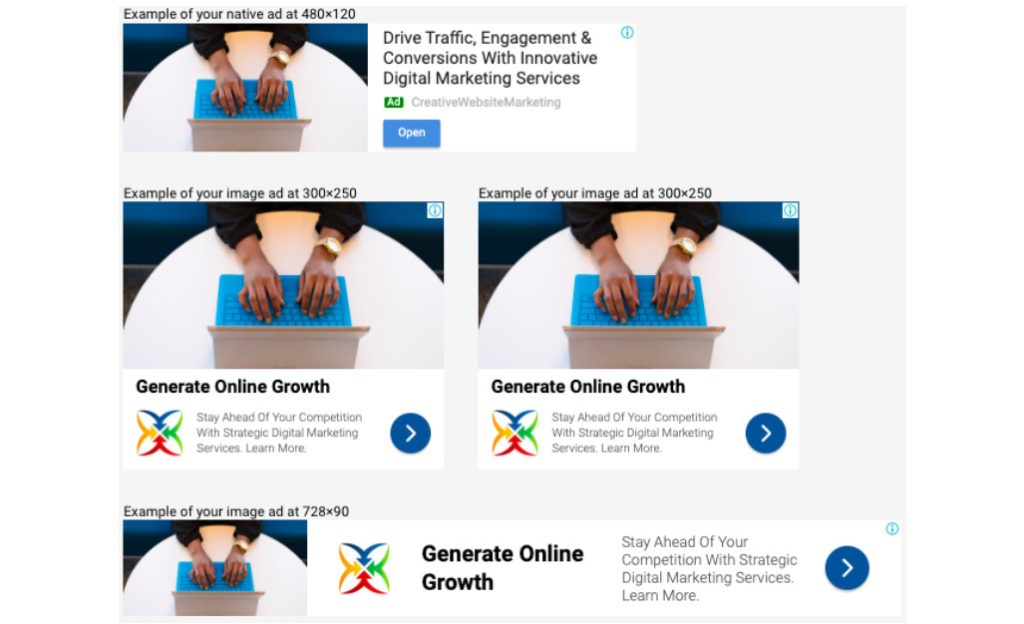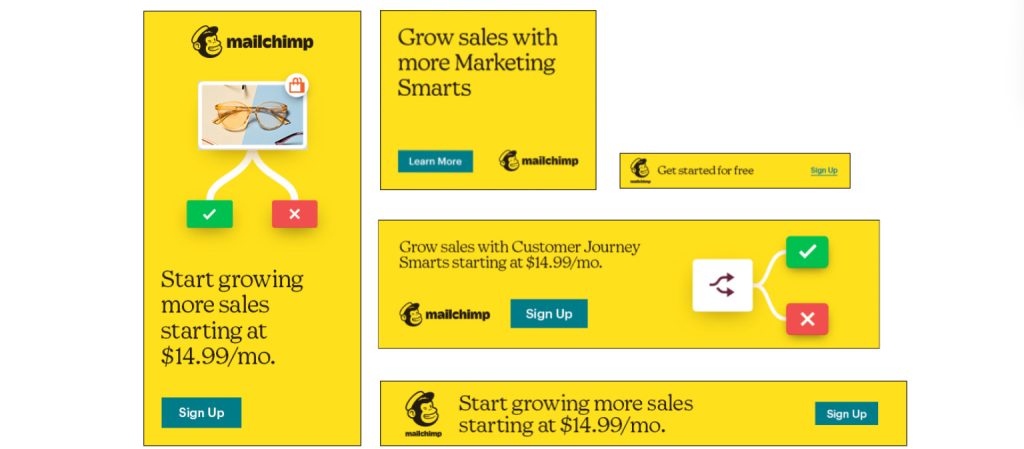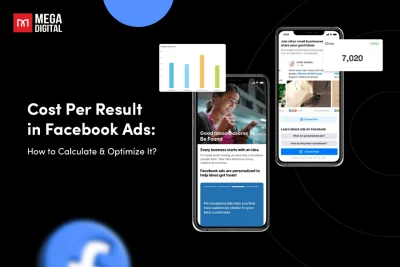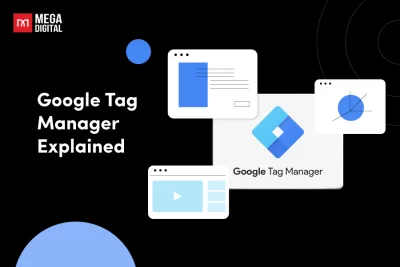Google Display ads can boost brand awareness by showing ads on various Google networks and websites. But how can you get the most clicks and potential leads for these ads? Here are some tips for creating eye-catching images or graphics combined with text, along with examples from Mega Digital’s Google Display ads best practices.
Table of Contents
#1. Separate Google Search & Display Networks
The key to this recommendation lies in understanding user intent. The Search Network and the Display Network engage users with entirely different mindsets. When users visit Google.com (or its search partners like Ask.com), they are actively seeking answers or services. Typing keywords into a search engine clearly indicates their intent.
On the other hand, the Display Network creates a disruptive experience. When users are on websites in Google Display Network, such as ESPN or The New York Times, they are there for scores or news, not to view your advertisements. So, when setting up your new Search Network campaigns, don’t be misled by Google’s default settings.

Of course, this notice isn’t new. In fact, Google Ads has been quietly including the Display Network in new Search campaigns for years. Therefore, regardless of your company’s size or budget, you should separate your Search Network and Display Network campaigns into two distinct campaigns.
As a result, you gain greater control over performance, budgets, and targeting options in your Google Display ad campaigns. Moreover, this approach significantly enhances your ability to optimize campaigns to cater to the distinct user intents of these two networks.
#2. Exclude remarketing audiences from general awareness
Another approach to optimizing Google Display ads is to separate remarketing audiences from new users. To effectively target your remarketing audiences, it’s essential to acknowledge the varying user intent within the same network, as we previously discussed in relation to the Search Network and Display Network.
It’s worth noting that even within a single network, user intent can differ. Users who have previously interacted with your website or viewed your YouTube videos are already familiar with your brand. Therefore, tailor your ad messaging to specifically engage users who are already familiar with your brand and its offerings.

Notice ‘Exclude audience’? You can create a clear separation between your remarketing campaigns and your general awareness campaigns. This approach serves a dual purpose:
- It helps minimize any potential overlap between the two audiences as much as possible.
- It enables you to adjust your budgets, bids, and landing pages to effectively target users who are further down the marketing funnel and more likely to convert.
Whether to separate remarketing audiences into their own campaigns depends on your budget and campaign goals.
#3. Create multiple responsive sets
According to Mega Digital’s experience, we recommend making the most use of the multiple responsive sets. This is our favorite among Google Display ads best practices. Segmentation based on actions and unique selling propositions (USPs) is recommended. This approach allows for a diverse range of campaigns, including:
- Brand awareness: Introduce your brand to both new and returning audiences.
- Remarketing: Target users who have shown interest in making a purchase on your site.
- Campaigns highlighting each USP: Showcase why users should choose your business over others. Identify your top reasons and create various Responsive ad campaigns to test their effectiveness.
- User actions: Focus on specific pages or sections visited by users on your website.

By organizing your campaigns in this manner, you can tailor your messaging and targeting to different audience segments. As a result, your Display ads will be more relevant.
#4. Create various assets
To achieve the best possible results for Responsive Display ads, we recommend using as many variations as possible. Google uses automatic optimization by testing multiple campaigns against each other to identify the most suitable options for your campaign goals.
To ensure high performance, it’s recommended to follow these steps:
- Utilize all five headline and description variation fields to maximize your messaging options.
>>> Read more: Google Ads Character Limit: Text Ads Guide for Beginners
- If possible, make use of all 15 image slots available. The recommended size is 1200 x 628 pixels, as Google will prompt you to crop them for both portrait and landscape placements once uploaded.
- Include your logo in different dimensions, such as square and horizontal/letterbox formats, to enhance brand visibility and recognition.

See these examples of responsive Display ads variations. Google undergoes testing and optimization to determine the most effective ad styles for your specific goals.
#5. Focus on the top-performing Display Ad sizes
Google offers a variety of dimensions for your banners. To ensure optimal appearance across diverse websites and platforms, prioritize selecting the most suitable Google Display ads size.

Here are the Display ads sizes that make up 90% of impressions in Google Ads:
| Ad size | Dimension |
|---|---|
| Square | 250×250 |
| Small square | 200×200 |
| Banner | 468×60 |
| Leaderboard | 728×90 |
| Inline rectangle | 300×250 |
| Large rectangle | 336×280 |
| Skyscraper | 120×600 |
| Wide skyscraper | 160×600 |
These widely-used Display ad sizes have a range of ratios in both vertical and horizontal formats. This flexibility ensures that your ads can be placed in various positions on website pages, including header banners or within text sections. Moreover, these ad sizes are optimized for Google so they are suitable for various devices.
#6. Only focus on one message
When designing Google Ads banners, simplicity is key. Focus on one message and avoid overwhelming your audience with excessive information. Consider the following:
- Audience awareness: How family is your brand to the target audience? Are they already aware of your brand, or are they cold leads?
- Campaign objective: Clearly define what you want to achieve with your ad banner. Whether it’s generating leads, driving sales, or promoting a specific offer, keep your objective in mind.
- Prioritize click-through: Remember that your landing page will provide detailed information to users. Your ad banner should serve as a persuasive gateway to encourage users to click through to your landing page. Keep your ad content concise, engaging, and focused on enticing users to take action.
- Consider animated banners: If you find it challenging to include all relevant information in a single static ad, consider using animated banners or slides. This allows you to convey your message effectively within a limited space.
By simplifying your ad design, focusing on one clear message, and utilizing concise content, you can create compelling and effective Google Ads banners that drive user engagement and encourage click-throughs to your landing page.

Take a look at Samsung’s simple yet elegant tablet ad. It specifically targets creative individuals. Moreover, the ad cleverly appeals to the competitive nature of their loyal customers.
#7. Use your brand theme colors
Use your brand theme colors to your advantage. By staying true to your brand identity, you can build brand awareness among users who come across your ads on various platforms and locations. This will also help users easily recognize your products and memorize your brand colors. As a result, your ads will maintain a consistent presence and stand out as your brand continues to expand and grow.

When you look at Apple’s Display ads, you’ll notice they consistently use a white color tone. This is a deliberate choice to remind viewers of their minimal and elegant designs. By sticking to this consistent white color, Apple reinforces their brand image and creates a cohesive visual experience across their ads.
#8. Add a unique CTA button
Adding a button to your ad increases the click-through rate. To make the button more noticeable, choose a bold color that stands out and carefully select your wording. Some common CTA phrases are:
- Click Here
- Learn More
- Watch Now
- Register Here
These phrases will trigger the audience to click on your ad. Typically, the CTA is positioned in the bottom half of a Display ad.

An excellent example of an effective CTA strategy comes from Vimeo, a software company. They took their CTA strategy to the next level by including their value proposition on the button. Additionally, they creatively and playfully mentioned it in the ad copy, adding an extra layer of engagement to their approach.
No matter how you apply best practices to your Google Display ads, adding a relevant call-to-action (CTA) button remains a determining factor.
#9. Align your landing page and Display ad designs with your brand guidelines
Consistency is key in maintaining a strong brand image across your marketing efforts. When your brand proposition remains consistent across different platforms, it becomes easier to build brand awareness and loyalty.

In addition to aligning with your brand’s visual identity, make sure your ads visually match your landing page in terms of colors and fonts. A seamless transition from your ads to your landing page enhances trust and improves the user experience.

Brand consistency goes beyond visuals and fonts. It also encompasses your message, tone, and word choices. Therefore, besides Google Display ads best practices, keep this in mind. If you’re promoting a specific value in your Display ad, ensure that your landing page provides relevant information about that value.
Wrap up
These are the best strategies for Google Display ads optimization. By applying various Google Display Ads strategies and tips, you can identify your target audience segments, develop top-performing Display ads, and generate sales and leads for your business.







